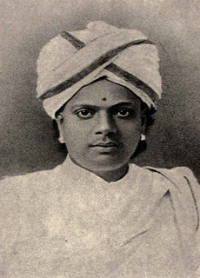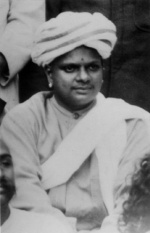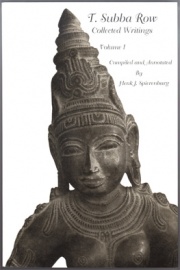T. Subba Row

Tallapragada Subba Row Garu (July 6, 1856 - June 24, 1890) was a brilliant Advaita Vedantist who became an early Theosophist. His surname was also spelled Subba Rao, and his first name is also Tiruvalum. A strict Brahman, he was trained as a Vakil (Pleader) within the Indian justice system, a highly profitable profession. He practiced law at Madras. In 1882, after corresponding with H. P. Blavatsky, Colonel H. S. Olcott and Damodar K. Mavalankar, he became a member of the Theosophical Society. Subba Row resigned from the Society in 1886 when an appeal was made to HPB by forty-five prominent members of the American Section to publish The Secret Doctrine without delay, which he considered to be premature.
Early years
Subba Row was born at Kakinada in Godavari District, Andhra Pradesh to a distinguished Brahmin family of civil servants and officials. He grew up in the household of his uncle after his father passed away. During a pilgrimage to Benares (now Varanasi) in 1869, the young man met a yogi who initiated him into Brahma Vidyâ. From that time onwards he performed the prescribed daily prayers and meditation. He was educated at the Hindu school in Kakinada, and earned a Bachelor of Arts degree at Madras Presidency College in 1876. His legal career started in the latter part of the same year with an appointment as Registrar of the High Court in the state of Baroda.
After a year he returned to Madras (now Chennai) where he continued his studies and passed the Bachelor of Law examination. He joined the legal firm of Grant and Laing and was enrolled as a Pleader of the High Court in the latter part of 1880. He practised law for ten years, appearing in important cases, and was held in high esteem both by the Bench and by the Bar.[1]

Theosophical work in Adyar
Subba Row became aware of The Theosophist published by Madame Blavatsky and Colonel Olcott. He began corresponding with the two Founders and contributed some valuable articles on Hindu religion and philosophy to their magazine. Later he became an editor.
In 1882, Subba Row invited Blavatsky and Olcott to Madras (now Chennai). His presence there was an important factor in the purchase of the Adyar property that became the permanent headquarters for the Theosophical Society. Upon his meeting them on April 23 of that year, Subba Row became able to recite whatever passage was so requested of him from the Bhagavad Gita, Upanishads, and many other sacred texts of India. He had, apparently, never studied these things prior to the fateful meeting, and it is stated that when meeting Blavatsky and Damodar K. Mavalankar, all knowledge from his previous lives came flooding back. Prior to this meeting, however, Subba Row was not known for any esoteric or mystical knowledge, even by his closest friends and parents. It was only after meeting the pair that he began to expound on metaphysics, astounding most of those who knew him.
T. Subba Row gave no early signs of possessing mystical knowledge: . . . I particularly questioned his mother on this point, and she told me that her son first talked metaphysics after forming a connection with the Founders of the Theosophical Society: . . . It was as though a storehouse of occult experience, long forgotten, had been suddenly opened to him; recollections of his last preceding birth came in upon him: he recognized his Guru, and thenceforward held intercourse with him and other Mahatmas; with some, personally at our Headquarters, with others elsewhere and by correspondence. He told his mother that H.P.B. was a great Yogi, and that he had seen many strange phenomena in her presence. His stored up knowledge of Sanskrit literature came back to him, and his brother-in-law told me that if you would recite any verse of Gita, Brahma-Sutras or Upanishads, he could at once tell you whence it was taken and in what connection employed.[2]
Instruction of Westerners
Subba Row had initial problems with instructing non-Hindus. It was his distinct belief at the time that Hindu knowledge should remain with India, and not be extended to foreigners. In fact, even after passing over this hurdle, he was still especially private regarding his spiritual life, even to his mother and close friends. Unless the person he was speaking to had a deep understanding of mysticism, it was a closed topic for him.
Charles Webster Leadbeater regarded Mr. Subba Row as his "principal teacher on the physical plane" and wrote that "he never showed the slightest sign of distrust in his relations with me, but treated me always with the utmost kindness and real friendliness, and was most patient and painstaking in his instructions." He continued:
The afternoons and evenings which he spent with us upon the roof here at the Headquarters at Adyar were always times of vivid interest - times to which we looked forward with eager anticipation. We questioned him upon all sorts of subjects - all the many aspects of occultism - and he never hesitated a moment either for a word or an idea, but poured forth upon us a steady stream of the most valuable information. His erudition was never at fault, and hardly less marvellous than the vast extent of his knowledge was his extraordinary faculty of incisive expression. He could weave a romantic atmosphere round the most abstract of questions, and present them as living, clear-cut, real. His writings show his varied learning, but they give no impression of the brilliancy of his style and his remarkable fluency in oral instruction."[3]
The Secret Doctrine
For several crucial years, Subba Row was instrumental in establishing Theosophy in India. Mme. Blavatsky sent him the first draft of The Secret Doctrine, hoping that he would be a co-editor of it and add his knowledge of Hinduism.
At that time in 1884, it was intended to become a new version of Isis Unveiled with Subba Row writing most of the commentaries and the explanations. However, in January 1885, a new plan for The Secret Doctrine was formulated. HPB went to work on it and sent portions of the first draft to Subba Row for his opinion and corrections. He, however, refused to edit it or help with the writing as he found the text both diffuse and chaotic. Nevertheless, so great was HPB’s respect for her uncompromising critic that she started the whole work over again from the beginning. This no doubt contributed to the eventual success of her magnum opus.[4]
Colonel Olcott wrote of this incident, "when I reported [Subba Row's criticism] to H.P.B. she was greatly distressed, and set to work and went over the MS. most carefully, correcting many errors due to slipshod literary methods, and with the help of European friends making the book what it is now.[5]
Mahatma Letters

At the request of Madame Blavatsky, and with the concurrence of Mahatma Morya Mr. Subba Row considered instructing A. P. Sinnett in occult matters. Several letters related to this matter were collected in The Mahatma Letters to A. P. Sinnett. Mahatma Letter No. 58 (number 130 in the Barker system) was mailed on May 7, 1882 from Madras where Subba Row was editing The Theosophist in HPB's absence. In it he introduced himself to A. P. Sinnett, stated conditions under which instruction could take place, and asked whether Sinnett was familiar with Sanskrit.
Joy Mills states, "We know that Sinnett answered Subba Row's letter, although we do not know precisely how he replied. Subba Row sent the reply on to M [Morya], perhaps with a cover letter similar to the one addressed to HPB, extracts of which KH [Koot Hoomi] sent to Sinnett. It is clear that KH also read Sinnett's response to Subba Row."[6] Subba Row's guru, Mahatma Morya, told Sinnett to "have patience with Subba Row. Give him time. He is now at his tapas and will not be disturbed. I will tell him not to neglect you but he is very jealous and regards teaching an Englishman as a sacrilege."[7] Koot Hoomi reinforced that message, although he seems to have regarded the prospect of Sinnett receiving instruction from Subba Row with skepticism. He knew that Subba Row - a lawyer as well as an initiate - could not ignore "the unpassable Chinese wall of rules and Law" that Sinnett had insufficient capacity to respect.[8]
Sinnett's response must not have been satisfactory, because in his June 26, 1882 letter, Mahatma Letter No. 64 (Barker no. 131), Subba Row firmly declined to convey practical occult teachings to Sinnett:
The qualified assent which you were pleased to give to the conditions laid down by me necessitated a reference to the Brothers for their opinion and orders. And now I am sorry to inform you that anything like practical instruction in the ritual of Occult Science is impossible under the conditions you propose. So far as my knowledge goes, no student of Occult Philosophy has ever succeeded in developing his psychic powers without leading the life prescribed for such students; and it is not within the power of the teacher to make an exception in the case of any student. The rules laid down by the ancient teachers of Occult Science are inflexible; and it is not left to the discretion of any teacher either to enforce them or not to enforce them according to the nature of the existing circumstances. If you find it impracticable to change the present mode of your life, you cannot but wait for practical instruction until you are in a position to make such sacrifices as Occult Science demands; and for the present you must be satisfied with such theoretical instruction as it may be possible to give you.[9]
In 1884, Master Koot Hoomi wrote to Subba Rowa advising him how to work with a Jewish member, Abraham D. Ezekiel. The message was published as Letter 79 in Letters from the Masters of the Wisdom Second Series.
Controversy with H. P. Blavatsky
As a representative of the Shriṅgeri Maṭh, an Advaita monastery, Subba Row adhered to Hindu orthodoxy, and that led him into certain disagreements with Madame Blavatsky.
In December 1885 Subba Row delivered a lecture on the Bhagavad Gita at the Convention of the Theosophical Society held in Adyar, Madras. The lecture, entitled "Introductory," was published in the February 1886 issue of The Theosophist. In this lecture Subba Row criticized the Theosophical concept about the septenary constitution of the universe and human beings. The philosophical controversy began in April, 1887, when H. P. Blavatsky published in the same journal the article "Classification of Principles." This resulted in a number of remarkable articles between the two occultists discussing the subject as presented in the teachings of the trans-Himalayan School and those of Târaka Râja Yoga. "Their respective followers did their best, as followers always do, to magnify a difference into a quarrel; but we have Colonel Olcott's testimony that even to the day of his death Subba Rao always spoke kindly of our great Founder.[10]
Charles J. Ryan has written that Subba Row had several causes of disaffection from the Society. A. O. Hume and A. P. Sinnett had tried to get him to reveal practical means of producing psychic effects, and Subba Row was included in the Hodgson charges that Blavatsky was a Russian spy. Furthermore, "as a Brahman, he strongly disapproved of H.P.B.'s revelation of some of the inner meanings of the Hindu scriptures, hitherto concealed in the secrecy of the temples and utterly unsuspected by outside scholars."[11]
Resignation and death
Subba Row, as an orthodox Brahmin, was critical of Blavatsky's disclosure of certain hitherto esoteric teachings. In 1888, he resigned from the Theosophical Society along with J. N. Cook. Thereafter he fell gravely ill when he contracted a cutaneous disease, a sickness which manifested itself in an outbreak of boils in 1890 during his last visit to the Theosophical Society's headquarters in Madras. Despite the healing treatment by Henry S. Olcott he eventually died on June 24, 1890, saying that his guru had called him, and that it was time for his departure. He was cremated the morning after as per Hindu tradition.
Although he was a member for only about four years, he influenced significantly the Society and left an important legacy of esoteric teachings.
Subba Row Medal
The 1883 Convention honored Subba Row by establishing the Subba Row Medal, to be awarded to writers of works of outstanding merit on Eastern and Western philosophy.
Writings

Subba Row's contribution to Theosophical literature was significant, even considering the shortness of his life. The 1884 Adyar edition of The Secret Doctrine lists him after Blavatsky's byline as author: "Assisted by T. Subba Row Garu, B.A., B.L., F.T.S., Councillor of the Theosophical Society and Secretary of its Madras Branch."
The Union Index of Theosophical Periodicals lists 87 articles by Subba Row and 1 article by TSR.
A Collection of Esoteric Writings of T. Subba Row was a compilation of articles from The Theosophist, produced by Bombay Theosophical Publishing Fund in 1895, with an expanded version by the Theosophical Publishing House, Adyar, in 1931. Henk J. Spierenburg published a two-volume collection, T. Subba Row Collected Writings, through Point Loma Publications. Volume I has a biographical sketch and covers the topics of Buddhism and the sevenfold principles of man, while Volume II includes esoteric teachings on chakras, rays, devachan, and so on.
Many of Subba Row's finest works are available online:
- Notes on the Bhagavad Gita. Lectures first published in The Theosophist volumes VII and VIII, and assembled in book form in 1934 by Theosophical University Press.Theosophical University Press
- On the Bhagavad Gita. This was published in 1912 as No. 17 in the Adyar Pamphlets series, written with Nobin K. Bannerji. See Canadian Theosophical Association.
- First Ray in Buddhism. Katinkahesselink.net.
- What Is Occultism? First published in The Word, 1:4 (January, 1905). Theosophy Northwest.
- On the Idyll of the White Lotus, published in A Collection of Esoteric Writings of T. Subba Row. Bombay: Rajaram Tookaram, for the Bombay Theosophical Publication Fund, 1910. Available online at Wikisource. Also published as Comments on the Idyll of the White Lotus in pamphlet No. 8 in the Adyar Pamphlets series HPB.narod.ru.
- Occultism of Southern India. Katinkahesselink.net.
- Personal and Impersonal God. This was published in volume V of The Theosophist. Levir.com.br and Katinkahesselink.net.
- Places of Pilgrimage. This was published in 1915 as No. 58 in the Adyar Pamphlets series. Levir.com.br.
- The Twelve Signs of Zodiac. This was first published in The Theosophist of November, 1881, and was issued as No. 31 in the Adyar Pamphlets series in 1913. Canadian Theosophical Association.
Additional resources
Articles
- 87 articles about Subba Row in Union Index of Theosophical Periodicals.
- T. Subba Row (1856-1890) at Exploring Theosophy (David Pratt).
- A Recondite Scholar of Intelligence compiled by Dr N C Ramanujachary.
- T. Subba Row at TS Adyar Website.
- Subba Row at Theosophy Forward.
- T. Subba Row Online at Online Teosofiska Kompaniet Malmö Website.
- T. Subba Row at KatinkaHesselink.net.
- "A Lonely Disciple: Monograph on T. Subba Row, 1856-1890" by Dr N C Ramanujachary.
- Subba Row, T. in Theosophy World.
Books
- Chapter 15: T. Subba Row and Brahmanism. In H. P. Blavatsky and the Theosophical Movement by Charles J. Ryan, available online at Theosophical University Press.
Obituaries and biographical sketches
- Anonymous. "Death of Subba Row." Lucifer 6 (August, 1890), 509.
- Bharati, Ramananda. "Swami T. Subba Row (1856-1890)." 103 (July, 1982), 392.
- Hoskins, Ianthe. "Subba Row - A Biographical Note." The Theosophist 99 (February, 1978), 145.
- Jinarājadāsa, C. "Our Cover (T. Subba Row)." The Theosophist 54 (December, 1932), 363.
- Leadbeater, C. W. "T. Subba Rao." The Theosophist 32 (December, 1910), 445.
- Olcott, H. S. "Death of T. Subba Row (1856-1890) A Sketch of the Life of the late T. Subba Row." The Theosophist 11 (July, 1890), 576.
- Olcott, H. S. "A Sketch of the Life of the Late T. Subba Row." The Theosophist 108 (March, 1987), 239.
- Olcott, H. S. "T. Subba Row." The Theosophist 54 (December, 1932), 366. Reprint.
- Ransom, Josephine. "T. Subba Row (1856-1890)." The Theosophist 77 (July, 1956), 233.
- Rao, Digavalli Venkatasiva. "Swami T. Subba Row." The Theosophist 107 (October, 1985), 9.
Notes
- ↑ "T. Subba Row (1856–90)," The Theosophical Society, Adyar.[1]
- ↑ Henry Steel Olcott, obituary notice for Subba Row, The Theosophist XI (July 1890),577-8.
- ↑ C.W.L. [Charles Webster Leadbeater], "Theosophical Worthies: T. Subba Rao," The Theosophist 32.3 (December 1910), 447.
- ↑ "T. Subba Row (1856–90)," The Theosophical Society, Adyar.[2]
- ↑ Henry S. Olcott, Old Diary Leaves Volume 3, 398. See "The Life of T. Subba Row," T. Subba Row Online[3]
- ↑ Joy Mills, Reflections on an Ageless Wisdom: A Commentary on the Mahatma Letters to A. P. Sinnett, (Wheaton, Ill.: Theosophical Publishing House,2010).
- ↑ Mahatma Letter No. 46.
- ↑ Mahatma Letter No. 60.
- ↑ Mahatma Letter No. 64.
- ↑ "Theosophical Worthies: T. Subba Rao," The Theosophist 32.3 (December 1910), 447.
- ↑ Charles J. Ryan, H. P. Blavatsky and the Theosophical Movement, 2nd edition. Pasadena, Calif.: Theosophical University Press, 1975.[4]